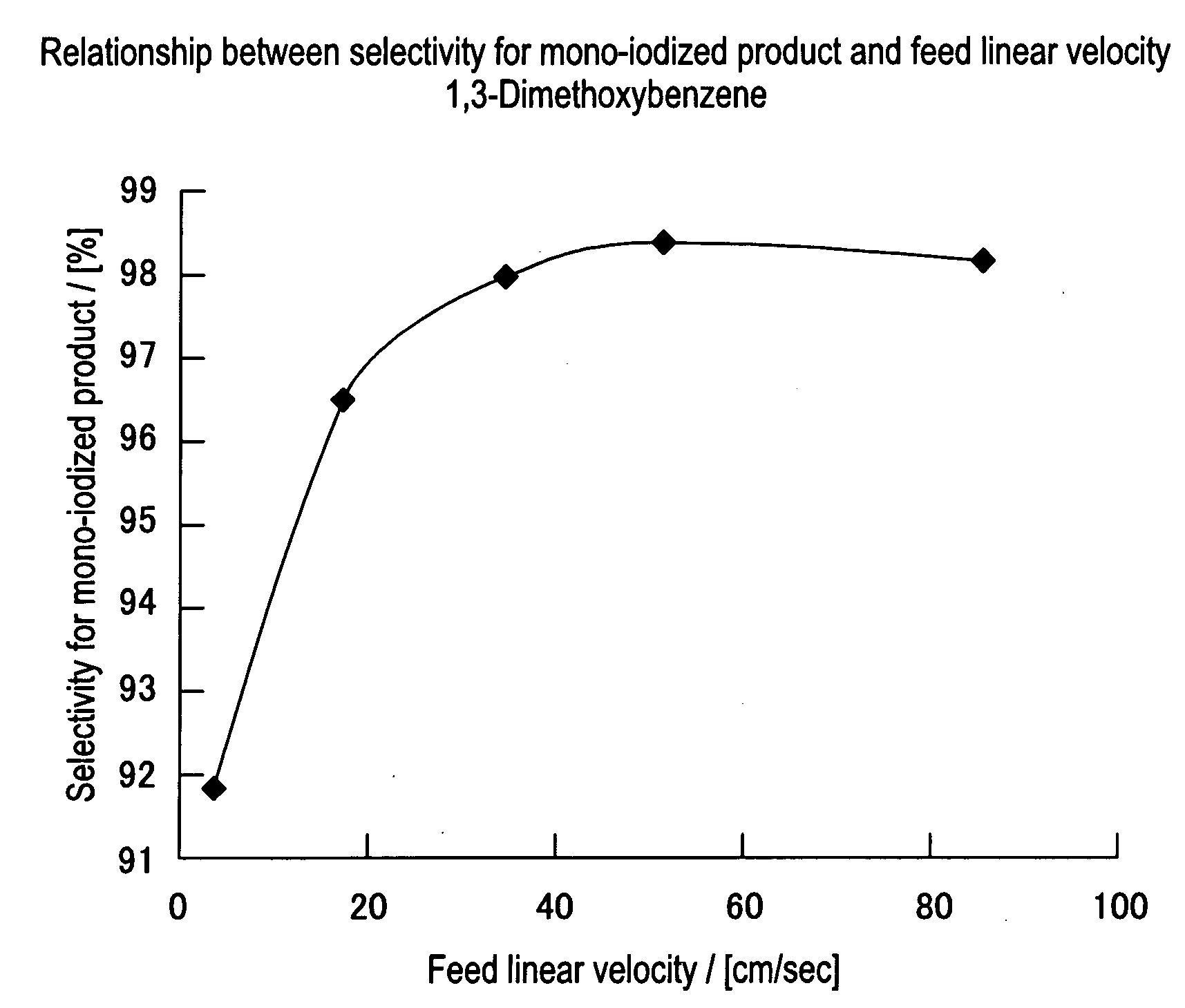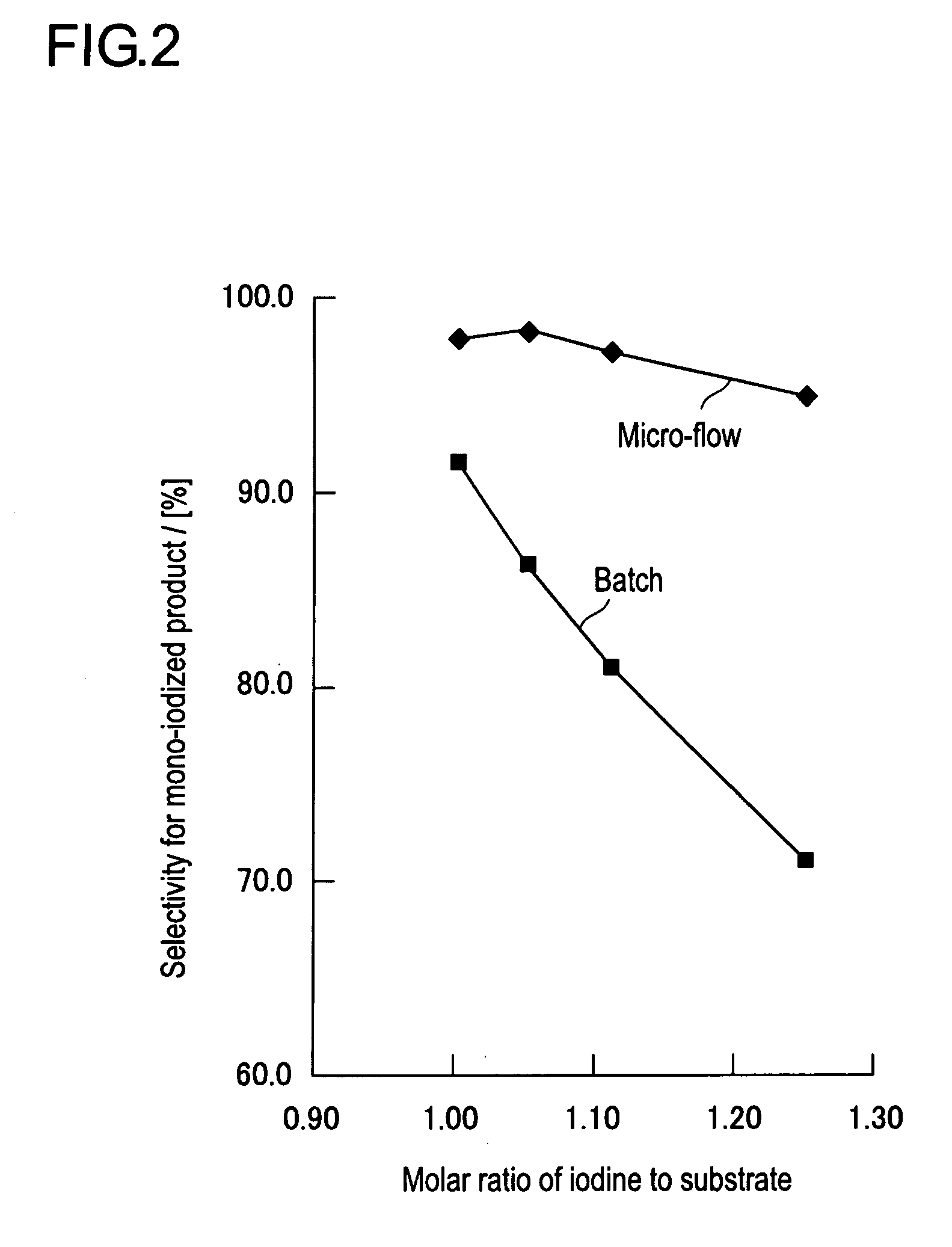Method for Producing Aromatic Iodides
- Summary
- Abstract
- Description
- Claims
- Application Information
AI Technical Summary
Benefits of technology
Problems solved by technology
Method used
Image
Examples
example 1-1
[0045]A flow reactor, in which a Teflon tube having an outer diameter of 1 / 16 inch, an inner diameter of 0.5 mm, and a length of 2 m, as a reaction section, was connected to an exit of a high-speed mixer (produced by IMM, Trade Name: SIMM-V2) having an equivalent diameter of 80 μm, was provided. To the feed inlet of the high-speed mixer, a syringe was connected via a Teflon tube having an outer diameter of 1 / 16 inch and an inner diameter of 0.5 mm.
[0046]Into a 100 ml Erlenmeyer flask, 30 ml of a saturated sodium bicarbonate aqueous solution, 1 ml of a saturated sodium thiosulfate aqueous solution, and 30 ml of diethyl ether were charged, and the solution was cooled to 0° C. on an ice-water bath while stirred with a magnetic stirrer. The high-speed mixer and the reaction section were also immersed into an ice-water bath to be cooled to 0° C. The exit of the reaction section was introduced into water layer in the Erlenmeyer flask.
[0047]Total amount of the active iodinating agent obtai...
example 1-2
[0051]Iodinating reaction and post-treatment were carried out under the similar conditions to those in Example 1-1, except that the feed flow rate was changed to 0.2 ml / min, to obtain 256.7 mg of a reaction product. In this case, the sum of feed linear velocity for each solution was 3.4 cm / sec. The reaction solution obtained by the reaction displayed pale yellow color.
[0052]NMR analysis and GC analysis of the reaction product gave 24.5 mg of 1,3-dimethoxybenzene, 205.2 mg (0.777 mmol) of 4-iodo-1,3-dimethoxybenzene and 26.9 mg (0.069 mmol) of 4,6-diiodo-1,3-dimethoxybenzene. Namely, ratio of the production rates of mono-iodized product and di-iodized product was 91.8:8.2.
example 1-3
[0053]Iodinating reaction and post-treatment were carried out under the similar conditions to those in Example 1-1, except that the feed flow rate was changed to 1.0 ml / min, to obtain 219.3 mg of a reaction product. In this case, the sum of feed linear velocity for each solution was 17.0 cm / sec. The reaction solution obtained by the reaction displayed pale yellow color.
[0054]NMR analysis and GC analysis of the reaction product gave 16.0 mg of 1,3-dimethoxybenzene, 193.1 mg (0.731 mmol) of 4-iodo-1,3-dimethoxybenzene and 10.2 mg (0.026 mmol) of 4,6-diiodo-1,3-dimethoxybenzene. Namely, ratio of the production rates of mono-iodized product and di-iodized product was 96.6:3.4.
PUM
| Property | Measurement | Unit |
|---|---|---|
| Length | aaaaa | aaaaa |
| Substance count | aaaaa | aaaaa |
| Substance count | aaaaa | aaaaa |
Abstract
Description
Claims
Application Information
 Login to View More
Login to View More - R&D
- Intellectual Property
- Life Sciences
- Materials
- Tech Scout
- Unparalleled Data Quality
- Higher Quality Content
- 60% Fewer Hallucinations
Browse by: Latest US Patents, China's latest patents, Technical Efficacy Thesaurus, Application Domain, Technology Topic, Popular Technical Reports.
© 2025 PatSnap. All rights reserved.Legal|Privacy policy|Modern Slavery Act Transparency Statement|Sitemap|About US| Contact US: help@patsnap.com



